Sink cabinets in the kitchen: types and choices
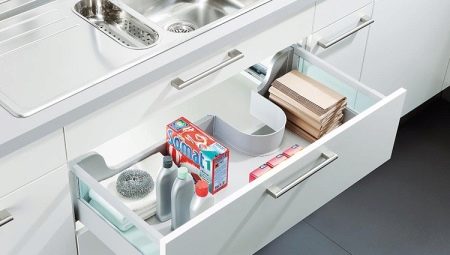
The convenience and functionality of a room such as a kitchen largely depends on the placement and type of furniture selected. Among the main components of a kitchen set, not the last place is occupied by sink cabinets, presented in various sizes, shapes and configurations.
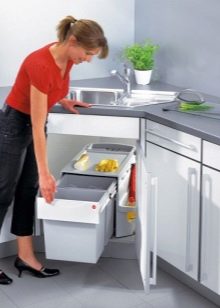
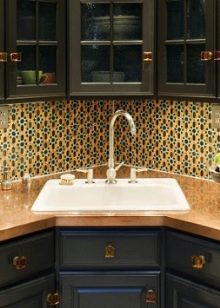
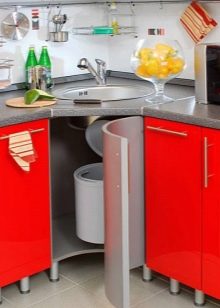
Features and purpose
A sink in a room such as a kitchen is an important part of the working area, without which the operation of the room for its intended purpose would be complicated. But to install such a component, for the most part, you will need special furniture, in the role of which the curbstone acts. She represents a small base cabinet without a lid or with a special hole for installing a sink.
In addition to the fact that this structure will serve as a frame for the sink, it performs a number of important functions in the kitchen.


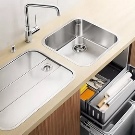
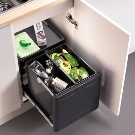
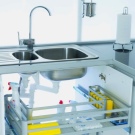

Among the main tasks it is worth highlighting the following.
- With the help of such parts of the kitchen set, it will be possible to hide some unattractive, but obligatory elements of equipping the room with the necessary communications. This applies to water pipes, filters, hoses, siphon and other important parts of the plumbing system.
- Thanks to the cabinet, during the operation of the sink and working with water, partial noise absorption occurs, in light of which it will be many times more comfortable in the kitchen to perform daily tasks.
- This design usually becomes a useful enclosed area where dishes, detergents, vegetables, trash cans, etc. can be stored.
- Thanks to the curbstone, it will be possible to make the interior in the room more harmonious.
- In small kitchens, part of the countertop can serve as a work area.However, this largely depends on the configuration of the sink and the size of the structure for it.
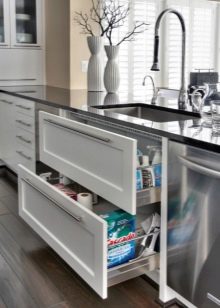
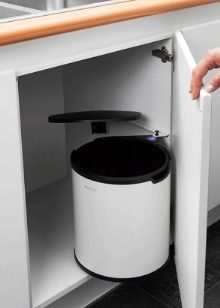
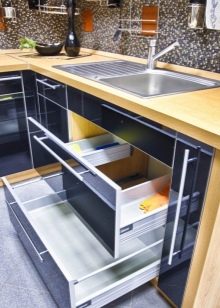
Types of structures
In order to make the right choice of such a component of a kitchen set, it is worth having an idea of the main types of such furniture. The classification of pedestals is carried out based on their shapes. Today manufacturers offer:
- straight structures for a sink;
- angle-type models;
- trapezoidal options.
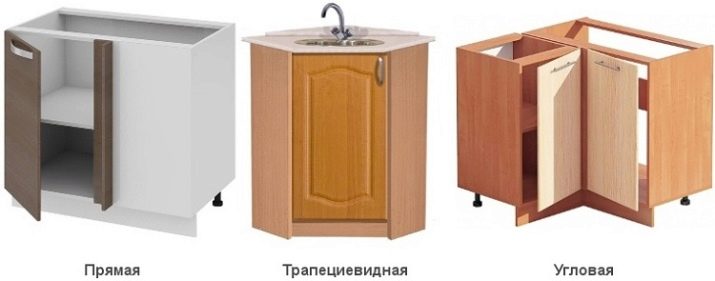
The first model is used most often in the light of comfort during operation. It is very easy to store various important things in such a component; for this, the cabinet inside is usually equipped with shelves, drawers, nets, etc. It is in this shaped cabinet that small household appliances can be installed.
The demand for such an option is due to the convenience and ease of access to the internal filling, in addition, a straight cabinet in the kitchen for the sink can be installed anywhere in the room as an extension of the countertop or a free-standing module. As a rule, these designs are the same size as the sink itself.
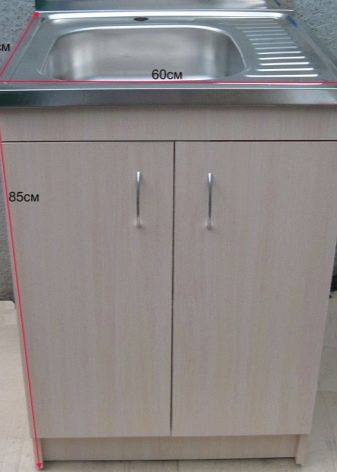

Corner models are most often purchased for kitchens with limited space. Thanks to the placement of the sink at the junction of the parts of the headset, it will be possible to save the usable area of the room, but in terms of the functionality of the internal space, such structures will be inferior to the first direct view.
This is due to non-standard dimensions, however, a way out of this situation can be special hanging brackets, cells or carousel boxes, some of which can be attached directly to the cabinet door.
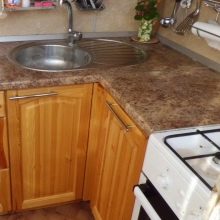
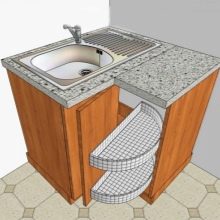

The corner-type washbasins are notable for their depth, therefore, having thought in advance how you can use the free area, it will be possible to equip the kitchen as functionally as possible without much difficulty. Corner structures can be L-shaped or triangular in shape. In any of the options, the installation of the module may require the help of a specialist.
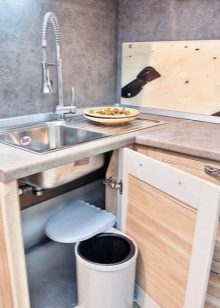
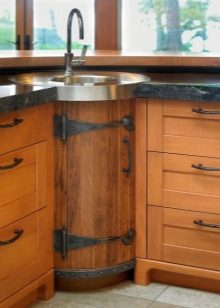

The trapezoidal sink cabinets are the most spacious among the above options. Due to the width of the internal area in such furniture, it is possible to store a lot of items, even non-standard and large-sized ones. In addition to the usual division of the area by doors into two zones, the trapezoidal cabinet can be further divided into compartments. In addition to the advantages on the inside, such countertops are usually more convenient to use from the top.

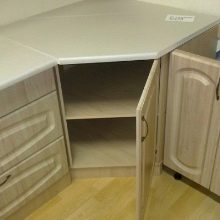
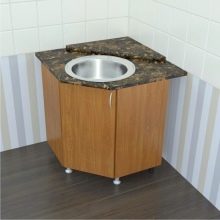
Manufacturing materials
Most often, manufacturers use three main types of raw materials for the manufacture of under-sink kitchen cabinets:
- solid wood;
- MDF;
- Chipboard.
Wood constructions are distinguished by their external attractiveness and environmental friendliness, in addition, they have a more presentable appearance in the general interior of kitchens. However, such products are distinguished by their high cost, which, together with the impracticality of wood for placing it near sources of water and high humidity, is often the main disadvantage in consumer choice. Such cabinets during operation will require a special approach to cleaning, since the wood is capable of swelling or crumbling from moisture.
When using such structures, they will require mandatory processing to protect them from damage.
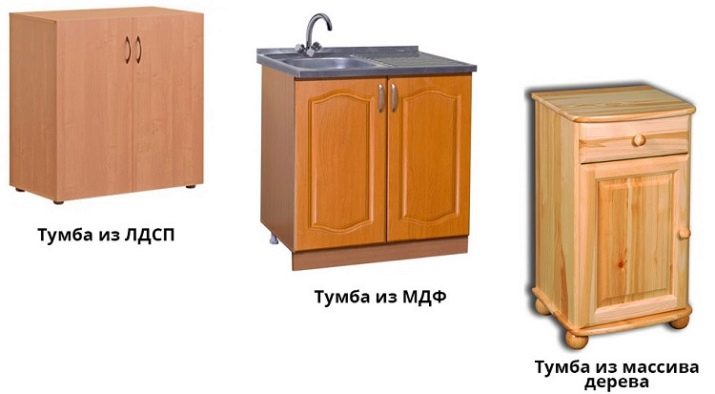
Curbstones from MDF are products made of particle boards glued on the basis of natural substances. This allows them to be classified as safe models for use in the kitchen with food. This raw material, unlike solid wood, is able to keep its shape well, the material is quite dense. Sink products are presented in a large variety of colors, usually the products are additionally coated with a special moisture-proof composition, which provides the furniture with a long service life.
Chipboard - practical raw materials with a completely democratic cost.From this material it will be possible to choose a cabinet for any kitchen set, since manufacturers offer their products in a wide variety of colors. However, in comparison with previous materials, chipboard stands out for its low environmental performance, since the laminating edges of structures are usually coated with special compounds that evaporate formaldehydes during operation and heating.
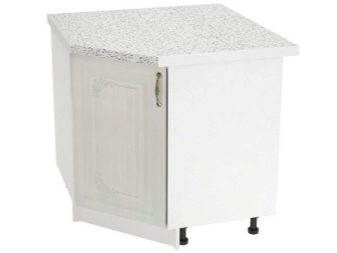
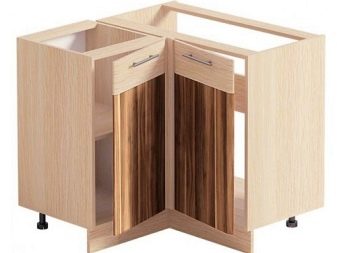
Washbasin installation methods
The classification of pedestals, depending on their configuration and the raw materials used for production, involves dividing the structure according to the type of installation of sinks. There are three main options that have their own individual characteristics.
Surface mounted washbasin installation
Most often used in practice. As a rule, straight pedestals are purchased for this. The essence of the installation is in removing the top panel from the structure, a sink is attached to the furniture instead, fixing at the edges along the entire perimeter. It is this installation option that is most often chosen for independent work, since even for inexperienced craftsmen, such work does not provide for any difficulties with further wiring of communications.


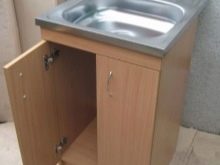
Mortise installation
To perform such an installation, in the purchased cabinet, a hole is usually made in the lid, into which the sink will be installed. In this option, it is important to ensure tightness of the joints during installation. As a rule, even a beginner can handle work related to wooden furniture.


Integrated installation
Similar work concerns the placement of the sink in such an option so that in the future the countertop would form a single whole with the sink due to a snug fit. It will take some experience to get a monolithic surface in the kitchen, therefore it is better to entrust all the basic manipulations with the curbstone to specialists.
Sinks for such an installation are most often made of artificial or natural stone. In terms of hygiene, they come first.
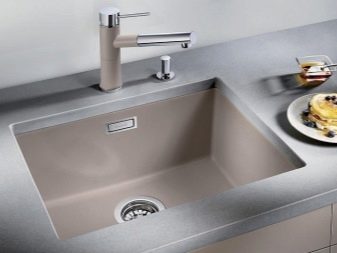
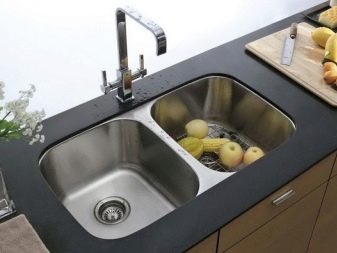
Dimensions (edit)
The dimensions of the cabinets with sinks will directly depend on the area of the kitchen itself, in addition, an important point is furniture installation method. It is worth noting that most often you can find standard sinks on sale, the width of which will be no more than 50 centimeters with a depth of about 55-60 centimeters, respectively, rectangular cabinets will have dimensions of 50x60 cm, sometimes 60x80 cm. the depth will be about 80-90 centimeters.
An important parameter of the pedestals will be the height. As a rule, it will depend on the size of the rest of the kitchen unit, as well as the depth of the sink. Usually these figures do not exceed 20 centimeters. It is best to select sinks for the curbstones so that they are a few centimeters smaller, so that there is still a little space on the sides of the table for a joint.
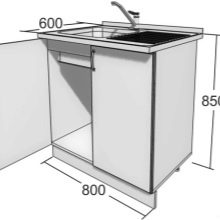

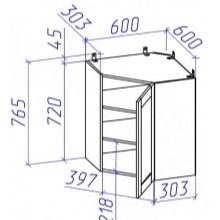
Manufacturers distinguish the following typical sizes of straight modules for sinks:
- depth - from 40 to 70 centimeters;
- height - from 70 centimeters to 1 meter;
- width in the range from 50 centimeters to one and a half meters.
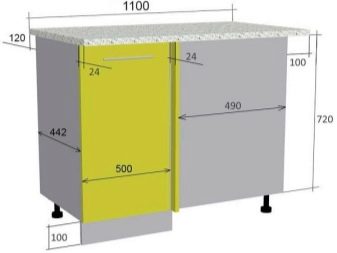
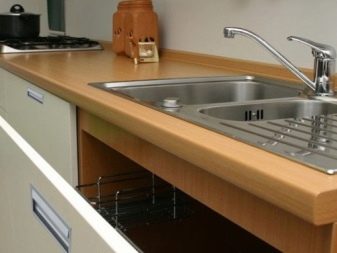
Corner pedestals are:
- depth - 30-80 centimeters;
- width - from 1 meter or more;
- height - from 70 centimeters to 1 meter.
Trapezoidal and other non-standard options are usually made according to individual measurements.
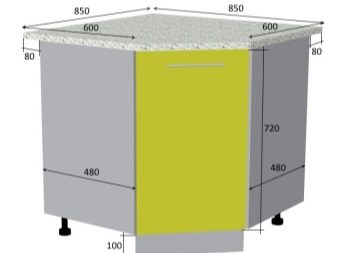
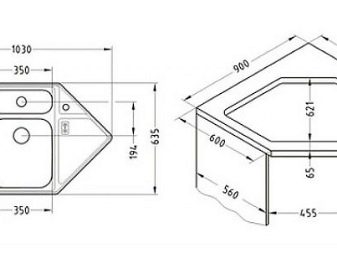
How to choose?
Since kitchen furniture manufacturers offer a variety of cabinet options in terms of design types, sink installation and color schemes, in the selection process, the following points should be taken into account.
- First of all, the option you like should be in harmony with the rest of the furniture and interior. In addition, there should be room in the room for options with a non-standard shape.
- It is best to purchase cabinets together with sinks, thus avoiding mistakes when buying.
- It is important to pay attention to the material from which the tabletop is made.The emphasis should be placed on the water-repellent properties of raw materials, since the operating life of the furniture depends on this. If you plan to use heavy stone sinks, you need to pay attention to such characteristics of the material of the pedestals as strength.
- If the choice fell on the corner structure, then an important nuance in this matter will remain ease of use, as well as freedom of movement during the use of the sink.
- The color scheme of the cabinet should be in harmony with the sink, so that they give the impression of a complete cabinet model. Among the alternative options, you can consider the choice of pedestals, in a single color scheme with a shade of flooring or other details in the interior.
- The inner filling of the cabinet plays an important role. When purchasing your favorite model, it is worth exploring the possibilities of rational use of the space under the sink, regardless of the size of the structure itself. As a rule, standard rectangular cabinets 600x800 mm will be able to accommodate not only a trash can, but also a set of cleaning products, boxes with vegetables, etc. As for the trapezoidal or corner options, even large containers can be placed inside them, for example, basins or pots.
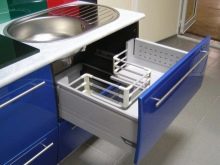

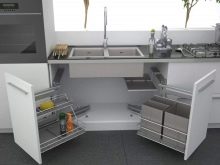
How to make a cabinet for a sink from plastic scraps with your own hands, see the next video.








